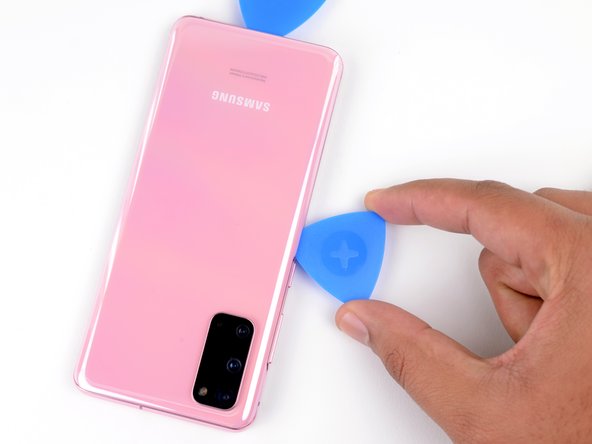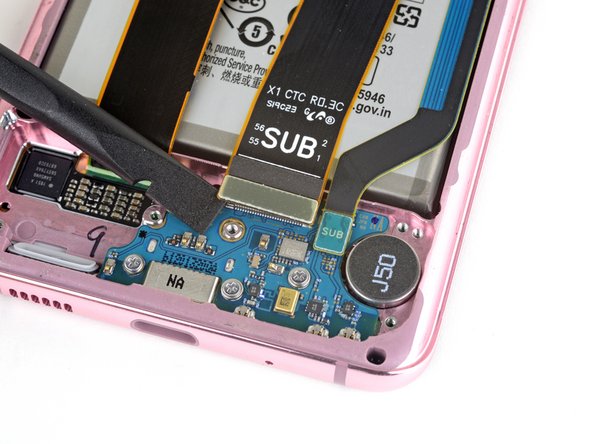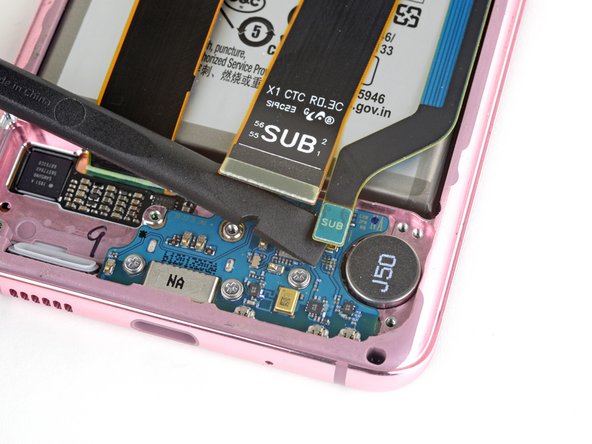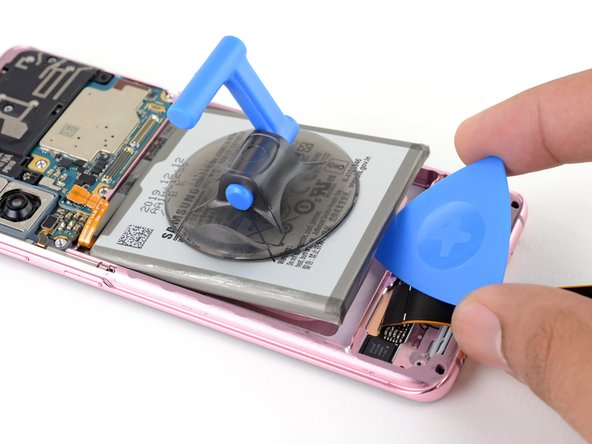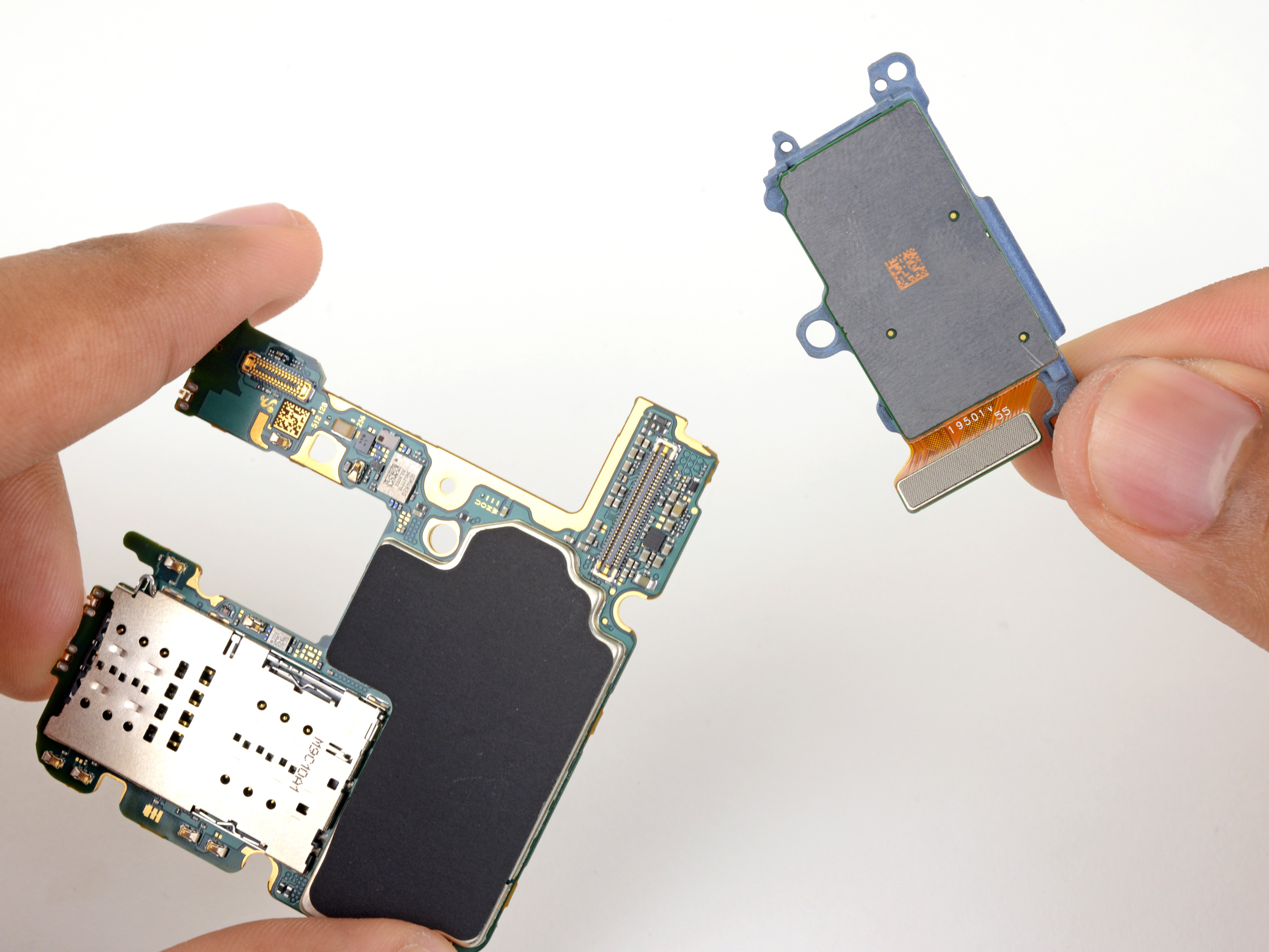Samsung Galaxy S20 Battery Replacement Guide
Duration: 45 minutes
Steps: 28 Steps
Uh oh! If your battery looks like it’s puffed up, handle it with care and definitely don’t put your phone on the grill.
For your own safety, make sure to drain that battery to below 25% before diving into the disassembly fun.
Ready to tackle the battery swap for your Samsung Galaxy S20? Let’s dive in! The battery is stuck in there pretty well thanks to some strong adhesive. To make things easier, grab some high concentration (over 90%) isopropyl alcohol to help loosen that sticky stuff. If your battery is looking a bit puffy, remember to play it safe and skip the heat. And for your own safety, make sure to drain your battery below 25% before you start taking things apart. This way, you’ll minimize the risk of any unexpected thermal surprises if the battery gets a little too adventurous during the repair. Don’t forget, you’ll need some replacement adhesive to finish the job. If you need help, you can always schedule a repair.
Step 1
Before you start, make sure to unplug your phone and power it off – safety first! If you need help, you can always schedule a repair
If you wanna use a hair dryer, heat gun, or hot plate to help things along, go for it! But be careful, don’t let the phone get too toasty. The display and battery are sensitive to heat and could get hurt. You can always schedule a repair if you’re not sure about anything.
– Give that iOpener a little heat therapy and press it against the bottom edge of the back cover for a cozy two minutes.
Tools Used
Step 2
Go easy on the pick—too much muscle and you might bust that back cover glass.
If your screen is sporting a serious crack, slapping a layer of clear packing tape on it might just do the trick to help the suction cup stick. Alternatively, you could go for some super strong tape instead of that suction cup. And if you’re really in a bind, a little superglue on the suction cup might just save the day!
Thanks to those snug tolerances, you might have to play the heating game a few times with the iOpener and give the suction cup another go before you nail it.
If you’re struggling to pop a gap open, don’t sweat it! Just add a bit more heat to the edge and give it another shot.
– Grab a suction cup and stick it to the back of your phone, aiming for the center of the bottom edge—you’re doing great!
– Now, pull on that suction cup with a good, steady force to create a little gap between the back cover and the frame. You’ve got this!
– Take the pointed end of an opening pick and gently slide it into that gap. Easy peasy!
Tools Used
Step 3
Hey, don’t get too crazy with that cutting tool! Avoid the corners where the glass curves, or you might end up with a cracked screen. We don’t want that, right? If you need help, you can always schedule a repair.
– Slide the pick back and forth along the bottom edge to slice through the adhesive. It’s like butter, baby! (Except it’s adhesive…but you get the idea.)
– Leave your opening pick in the seam to prevent the adhesive from resealing. Think of it as a little party favor for your phone!
Step 4
– Now it’s time to get this repair started – apply a heated iOpener to the left edge of the back cover for about two minutes. If you need help, you can always schedule a repair
Tools Used
Step 5
Be gentle with the pick, you don’t want to crack the back cover glass! If you need help, you can always schedule a repair.
Don’t worry if it takes a few tries to get it just right – these tight tolerances can be a bit tricky.
Since the glass on this edge is curved, you won’t be able to insert the pick too far in. Just make sure the tip is under the edge and you’re good to go.
Having trouble getting started? Try applying a bit more heat to the edge and giving it another shot. If you’re still stuck, remember that you can always schedule a repair with Salvation Repair for some expert help.
– First up, grab a suction cup and stick it right on the back of the phone, aiming for the center of the left edge. You’ve got this!
– Now, give that suction cup a good, strong pull. Steady does it! We want to create a little gap between the back cover and the frame.
– Next, slide the point of an opening pick into that gap you’ve just created. Easy peasy!
– If you’re feeling adventurous, you can also drip a few drops of high concentration (over 90%) isopropyl alcohol into the seam to help loosen up that pesky adhesive.
Tools Used
Step 6
– Now that the pick is under the edge of the glass, gently tilt it down and slide it in further to release the back cover’s adhesive. If you need help, you can always schedule a repair
Step 7
Be cautious when gliding over the ridge around the volume and power buttons—the glass cutout might be a little more delicate and could crack if you’re not careful.
– Now it’s time to get that back cover off – slide your pick along the left edge of the phone to loosen the adhesive that’s holding it in place.
– Leave your pick right under the top left corner of the glass, near the left edge, so the adhesive doesn’t start to stick back together – you’re making great progress! If you need help, you can always schedule a repair
Step 8
If you want to get a little extra heat on the situation, a hair dryer, heat gun, or hot plate can help. Just remember to be careful, as both the screen and the battery are pretty sensitive to heat. If things start getting too hot, you can always schedule a repair.
– Heat things up by applying a heated iOpener to the right edge of the back cover for about two minutes. If you need help, you can always schedule a repair
Tools Used
Step 9
Now, just like with the previous edge, you’ll want to give that opening pick a little tilt downwards. Go ahead and slide it all the way under the back cover!
– Grab your trusty suction cup and stick it to the back of your phone, aiming for the center of the right edge. Go for it!
– Now, give that suction cup a good, strong pull. We’re talking about making a little space between the back cover and the frame. You got this!
– Take your opening pick and gently slide it into that gap you just made. We’re almost there!
Step 10
Hey, no worries if the back cover lets go of those picks. It’s just trying to give them a little break! Don’t stress – just put them aside and know that the bottom edge won’t be sealing up again from here on out. 😉
– Let’s get that back cover off! Slide your pick along the right edge of the phone to loosen up that adhesive.
– Keep your pick tucked under the right edge near the top – we don’t want that adhesive sneaking back together!
Step 11
– Let’s get this party started! Heat up that back cover with a heated iOpener for two minutes. Get it nice and toasty. We’re going to be popping that back cover right off in no time! If you need help, you can always schedule a repair.
Tools Used
Step 12
Heads up! The back cover glass is kinda curvy near the corners, which makes it a little fragile. Be gentle when you’re working around those areas, so you don’t accidentally crack it. If you need help, you can always schedule a repair.
If you’re finding the slicing a bit tricky, take a breather and warm things up again before diving back in.
– Gently glide the pick from the right edge of your device, making your way around the top right corner.
– Keep slicing along the top edge until you reach the top left corner, ensuring the back cover adhesive is completely separated.
Step 13
– Time to get started! Carefully lift the back cover, using opening picks to gently slice through any remaining adhesive.
– Now, completely remove the back cover to access the inner workings of your device.
– Reassembly tip: This is a great opportunity to power on your device and test all functions before sealing it up. Just remember to power it back down completely before continuing.
– Next, use a pair of tweezers or your fingers to remove any adhesive chunks. If you’re having trouble, apply some heat to help loosen things up.
– If you’re using custom-cut adhesives, be sure to follow our guide for the best results.
– And if you’re using double-sided tape, we’ve got a guide for that too – just follow the steps and you’ll be all set.
– If you need help along the way, you can always schedule a repair with the experts at Salvation Repair.
Tools Used
Step 14
As you tackle this repair, keep an eye on each screw and make sure it finds its way back to its original home.
– Alright, time to get those screws out! Grab your trusty Phillips #00 screwdriver and take out those five little 4 mm-long screws holding the motherboard bracket in place. Don’t worry, they’ll come out easy-peasy. If you need help, you can always schedule a repair.
Tools Used
Step 15
Hold up! Don’t totally yank that bracket out just yet, it’s still chillin’ with the wireless charging coil.
– Grab a trusty pair of tweezers and gently lift up the motherboard bracket from the plastic midframe. You’ve got this!
Tools Used
Step 16
No need to disconnect anything here, the coil is connected with spring contacts! It’s like a little springy hug for your device. 😉
– Carefully lift the wireless charging coil away from the device—like peeling a banana, but with a bit more tech flair.
– Say goodbye to the wireless charging coil and remove it from its cozy spot.
– When you’re putting everything back together, start by securing the motherboard bracket screws first. This helps the charging coil fit snugly into place. Then, give the rest of the coil a gentle press to make sure it sticks just right!
Step 17
When disconnecting connectors like these, just a friendly reminder to watch out for those tiny surface-mounted components hanging out around the socket. They can be a bit skittish!
– Time to give that battery connector a little nudge! Use a spudger to gently pry it up and disconnect it. If you’re feeling a little unsure, you can always schedule a repair.
Tools Used
Step 18
– Grab your trusty Phillips #00 screwdriver and get ready to tackle this task! Carefully remove the five screws that are holding the loudspeaker and lower midframe in place. Each of these screws is about 4 mm long, so keep an eye on them as you go.
Tools Used
Step 20
– Time to get started! Use a spudger to carefully pry up and disconnect the main and auxiliary flex cables from the daughterboard near the bottom of your device. Take your time and be gentle to avoid any damage.
– Now, let’s get these connectors back in place. To reattach press connectors, align them carefully and press down on one side until you hear that satisfying click. Then, repeat on the other side. Remember, don’t press down on the middle, or you might end up bending those pins and causing permanent damage. If you need help, you can always schedule a repair with the experts at Salvation Repair.
Tools Used
Step 21
– Time to disconnect those cables! Use a spudger to gently pry up and disconnect the main and auxiliary flex cables from the motherboard. Don’t worry, it’s like a little dance – just be careful not to pull too hard. If you need help, you can always schedule a repair.
Tools Used
Step 23
– Time to unleash the power of the spudger! Gently pry up and disconnect the main display flex cable from the motherboard. It’s like a little dance, just be careful not to force it. If you need help, you can always schedule a repair.
Tools Used
Step 24
– Carefully lift and bend the display flex cable to clear the path for the motherboard and battery.
Step 25
Be careful with the alcohol, too much can make your display feel a little under the weather!
– Give that battery a little love! Apply 1-2 drops of high concentration (over 90%) isopropyl alcohol to the top edge of the battery.
– Let the alcohol work its magic for a minute. It’ll help loosen up that sticky situation!
Tools Used
Step 26
– Start by placing a suction handle right in the middle of the battery. You’ve got this!
– With one hand, hold the top and bottom of your device against your work surface, and with the other hand, give that suction handle a nice, steady pull upwards.
– Once you see the battery starting to lift away from the device, you’re ready to move on to the next step. Keep it up!
– Remember, the adhesive likes to take its time, so instead of yanking hard, try pulling steadily for about 15 seconds at a time. Patience is key!
– If the battery is still playing hard to get, drop 1-2 drops of isopropyl alcohol along the top, left, and right edges, wait a minute, and then give it another gentle pull.
Tools Used
Step 27
Hold your horses! Make sure the battery has popped up enough for you to easily slide in an opening pick underneath. If it’s still stuck like glue, you might end up jabbing the battery and creating a thermal fumble, and nobody wants that!
Once that battery is on the move, steer clear of isopropyl alcohol! Letting it sneak into your fingerprint sensor could lead to some screen drama.
– Slide an opening pick under the bottom edge of the battery and give it a little twist to break that pesky battery adhesive free.
Tools Used
Step 28
When you’re done with that old battery, don’t even think about putting it back in – it’s time to let it go. Grab a brand new one to keep your device safe and running smoothly. If you need help, you can always schedule a repair
– First things first, let’s get that battery out of there! Remove it with care.
– Next up, say goodbye to any leftover battery adhesive! Peel it off or give it a gentle scrape, then grab some isopropyl alcohol and a lint-free cloth to clean that battery well surface like a pro.
– If you went for the isopropyl alcohol route, hang tight for about ten minutes. We want to make sure all that alcohol has evaporated before we pop in the new battery.
– Now, when you’re putting everything back together, if your shiny new battery doesn’t come with its own adhesive, no worries! Just apply some to the well and press that new battery in firmly. You’ve got this!
Tools Used

















